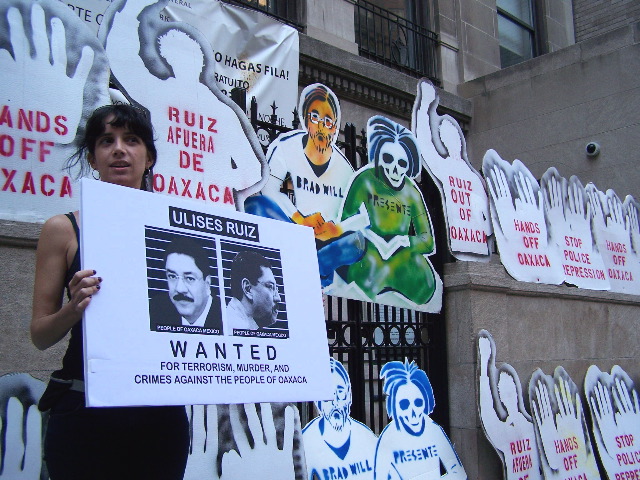Women's Mission Statement
“Our mission as women is to create, educate, communicate, and participate,” stated Fidelia Vasquez, a member of the Section 22 teachers’ union in Oaxaca, Mexico [23]. With endless passion and drive, women in Oaxaca have played a major role in the social and political upheaval that has occurred in their country. They have been constantly fighting for their rights for over thirty years. Years later, after hearing a speech by feminist Celia Amorós at the Oaxacan Congress Building in 2006, their beliefs were reaffirmed and they concluded that feminism could not exist without democracy. Following this, they began to take more severe action in the issues of the place they called home [24].
Photo by Sarah Ferguson
The Protesting Begins
When the teachers’ strike began in May of 2006, Section 22 of the teachers’ union demanded higher wages, better health and pension plans and building maintenance, among other things [25]. Women make up over 60% of all teachers in Mexico [26]. The Section 22 teachers’ union is composed of 157 Oaxacans, a third of them women [27]. The union was formed after breaking away from the government union with hopes to make the education system more democratic [28]. On May 1, 2006, many Oaxacans, including more than 40,000 female teachers that were members of Section 22, protested in order to free media that is usually government regulated [29]. By doing this, they were able to express their requests peacefully with millions watching. Ruiz declined to comply with their needs. Instead, he went one step further and issued an attack on the citizens of Oaxaca, which ended with the formation of the APPO [30]. The feminists in Oaxaca have done their best to support this group and their efforts to aid the teachers in their fight for an adequate education system.
Photo by James Daria
On August 1, 2006, between three and four thousand women marched, banging on pots and pans, with the intention of taking over media outlets that were controlled by the government [31]. They waved signs reading “When a woman gets going, no man can hold her back!” [32]. When their demands were not met, they held sixty radio and television staff (all women) hostage without harming them, before they went on the air and informed the public of the important news that was not being aired [33].
Photo by James Daria
Women and the Media
Serving as the driving force in the radio station movement that occurred in Oaxaca, women voiced their opinions over the air demanding democracy and freedom from the corrupt government. In the past, they have not been looked at as capable of representing the people of Oaxaca. Nevertheless, they proclaimed that they were “the face of Oaxaca,” or rather, the voice [34]. Oaxacan women used radio as a tool to organize their movement and increase awareness in a peaceful way.
Also influential to the events that occurred in Oaxaca were filmmakers that have made documentaries illustrating what is not known to the public about the struggles the teachers have faced. The historical documentation of the social and political events that have occurred in Oaxaca is essential because it informs larger populations about the effort that the citizens of Oaxaca have put forth and it allows the events to go down in history. An example of one of the prominent female filmmakers is the award-winning Jill Friedberg, who directed the movie, “Un Poquito de Tanta Verdad.” This film highlighted specific struggles that the APPO and the teachers’ in Oaxaca have faced in the last few years, and made their problems known to the United States. This film was shown at the University of Michigan to a number of people, including a Latin@ studies class in the American cultures department.
